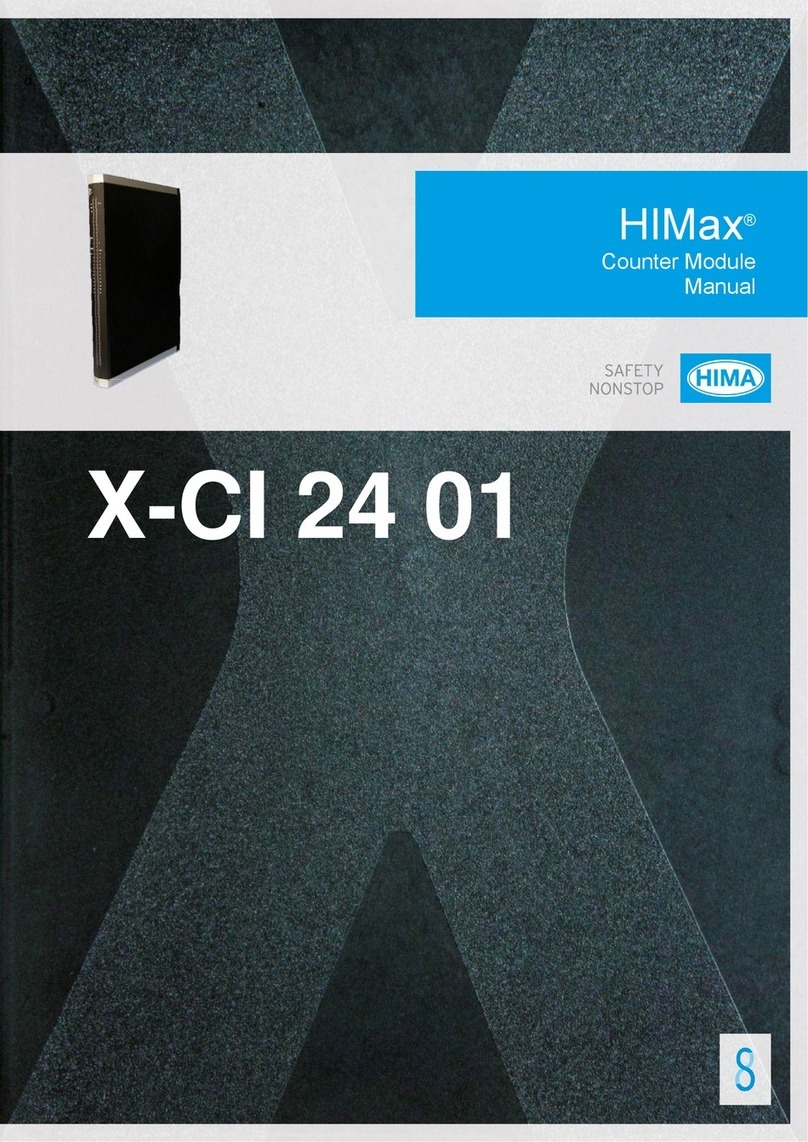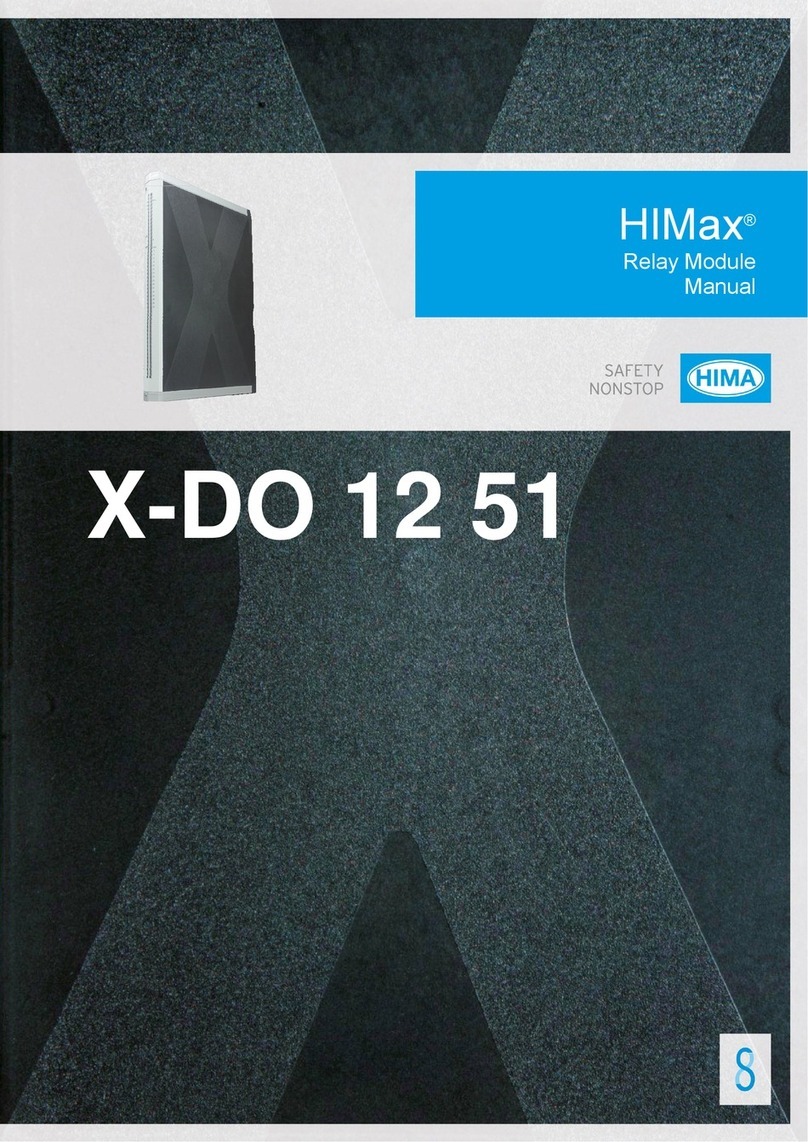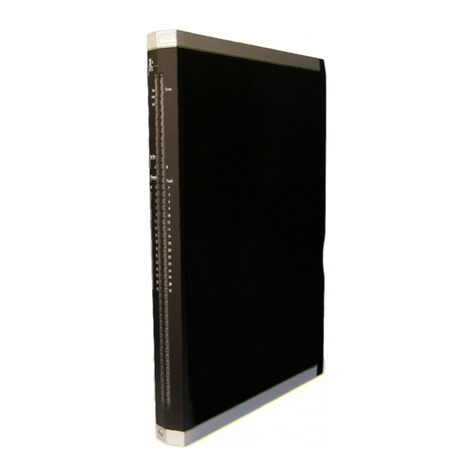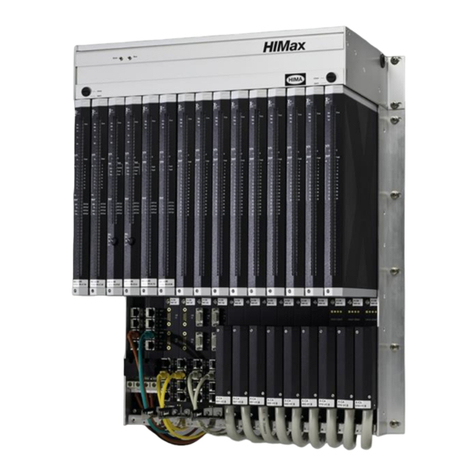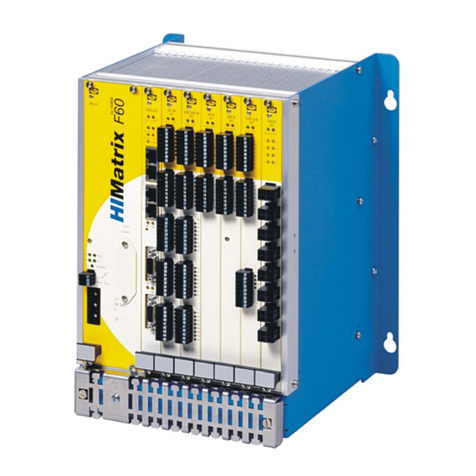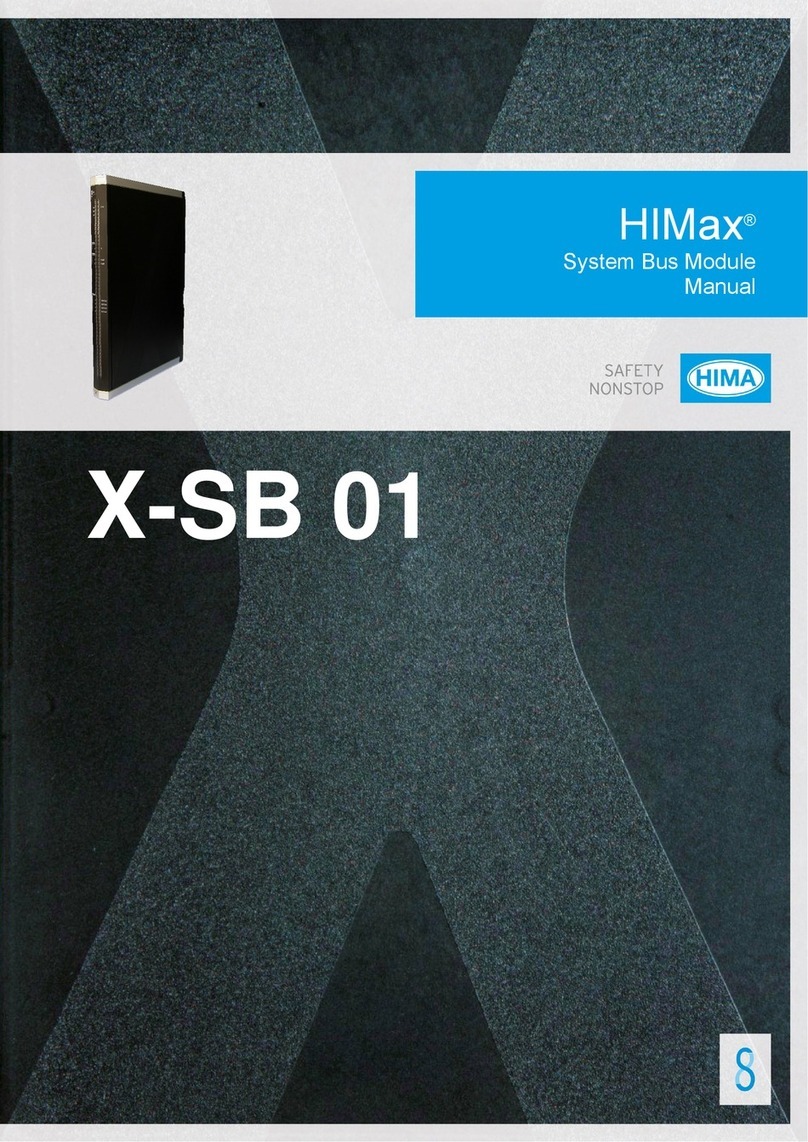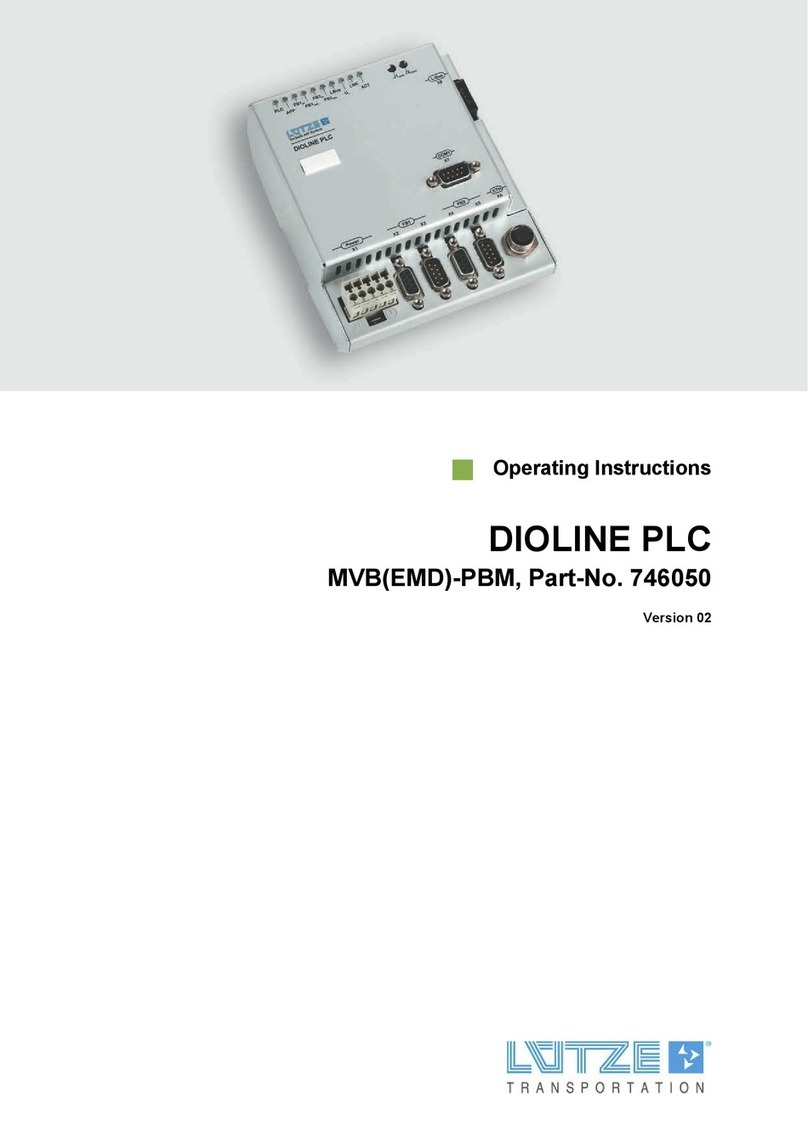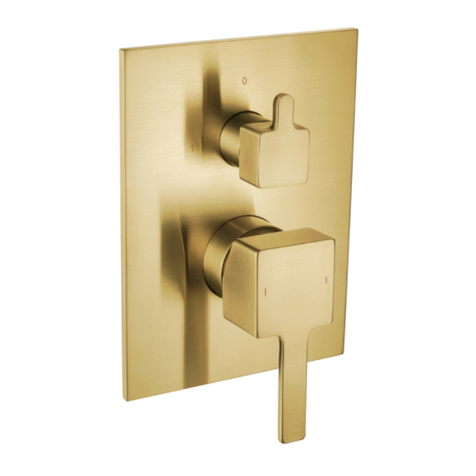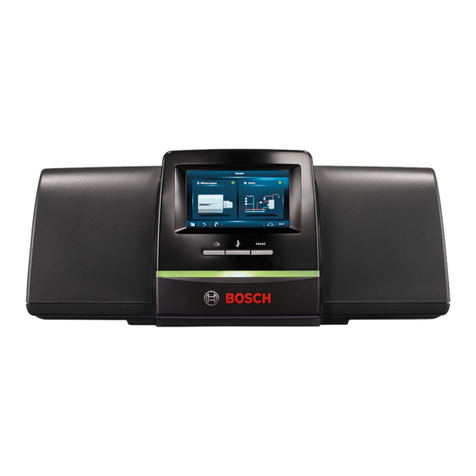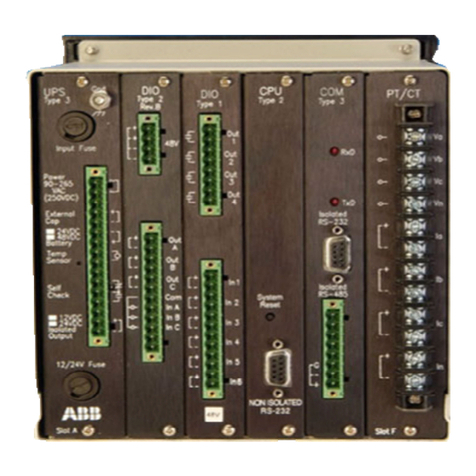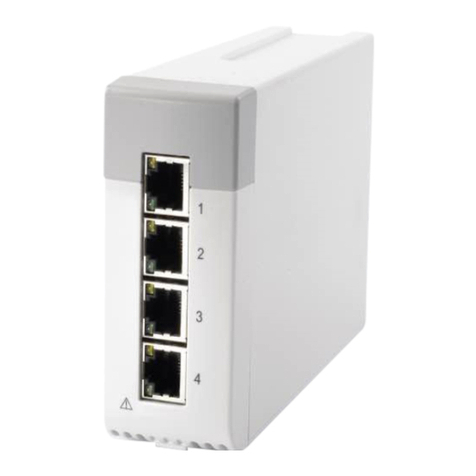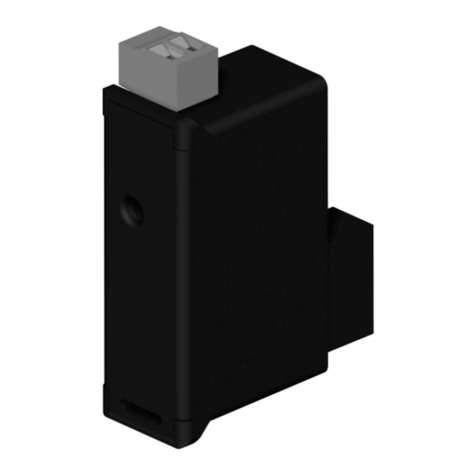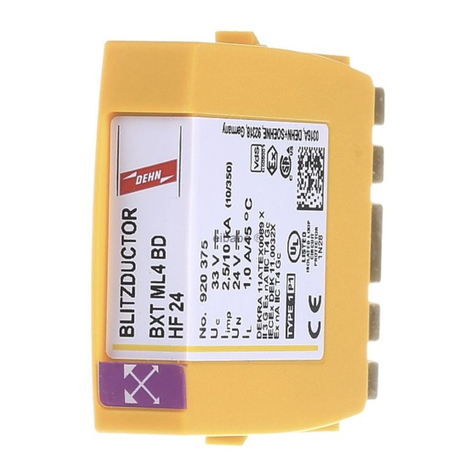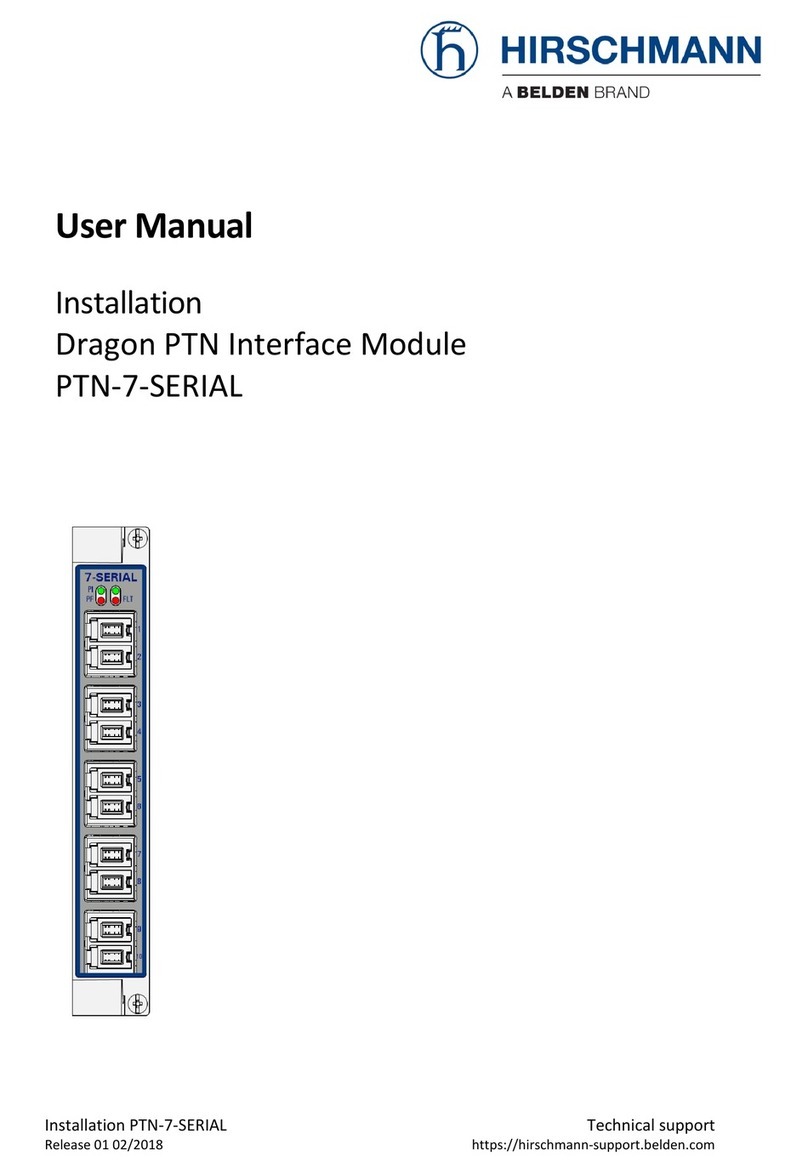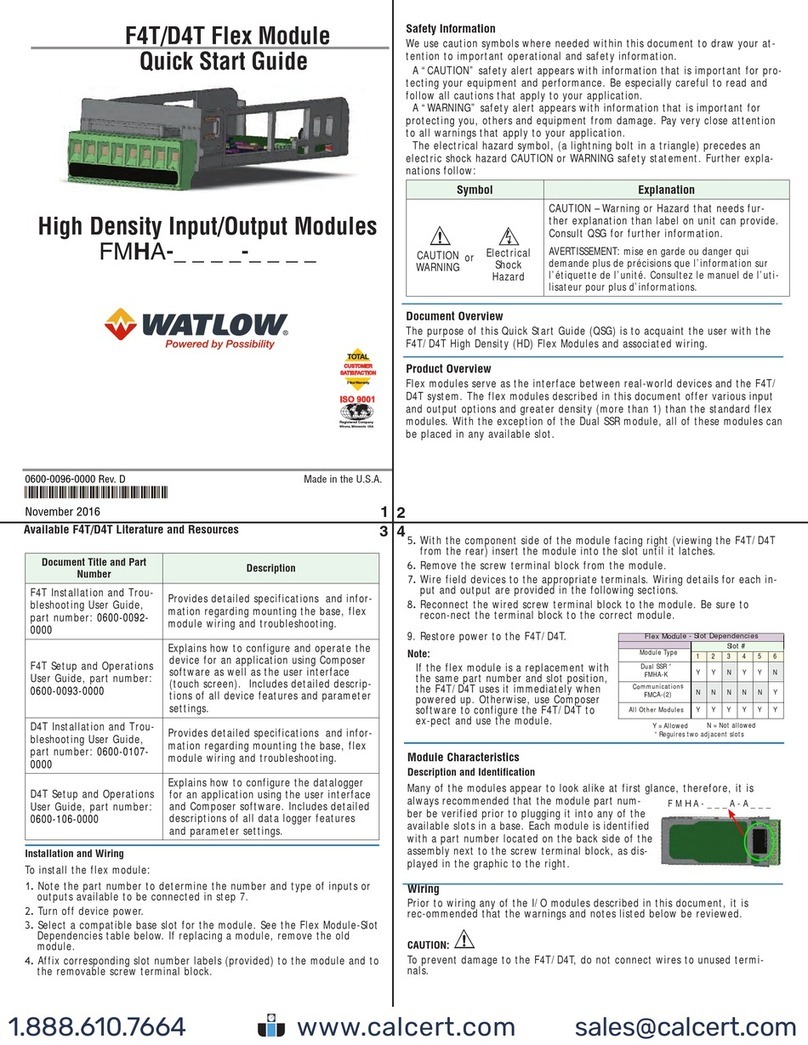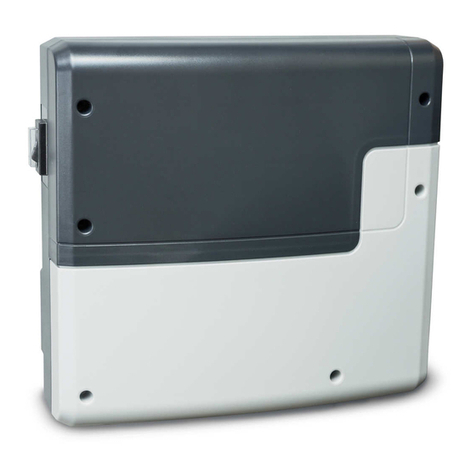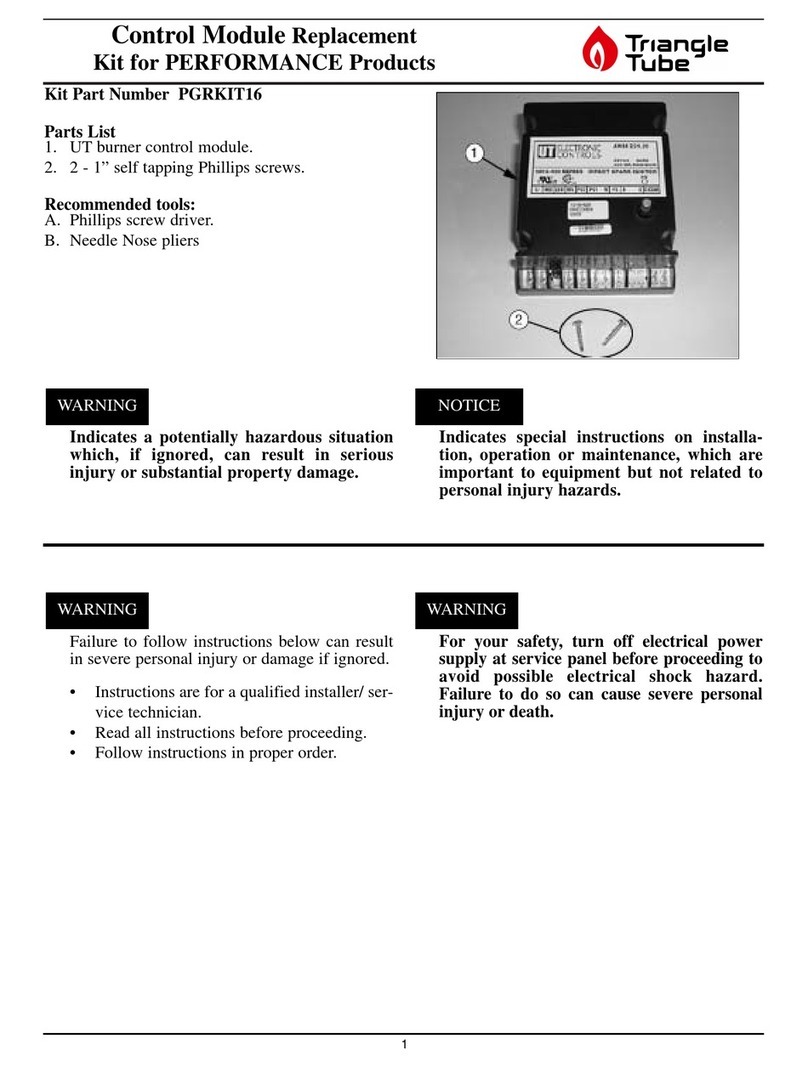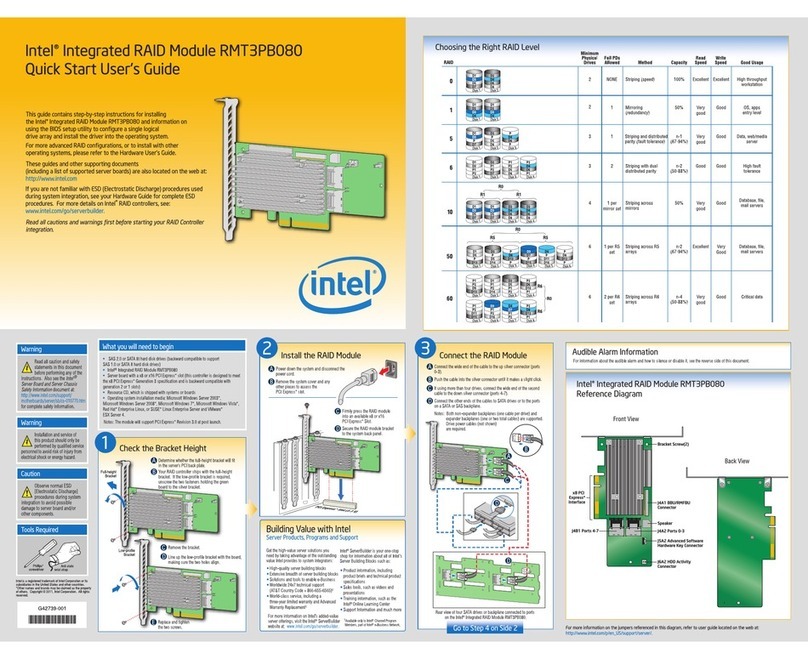HIMA DIO 24/16 01 User manual

HIMatrix
Safety-Related Controller
DIO 24/16 01 Manual
HIMA Paul Hildebrandt GmbH + Co KG
Industrial Automation
Rev. 1.01 HI 800 205 E

HI 800 205 E Rev. 1.01 (1022)
All HIMA products mentioned in this manual are protected by the HIMA trade-mark. Unless noted
otherwise, this also applies to other manufacturers and their respective products referred to herein.
All of the instructions and technical specifications in this manual have been written with great care and
effective quality assurance measures have been implemented to ensure their validity. For questions,
please contact HIMA directly. HIMA appreciates any suggestion on which information should be
included in the manual.
Equipment subject to change without notice. HIMA also reserves the right to modify the written material
without prior notice.
For further information, refer to the CD-ROM and our website http://www.hima.de and
http://www.hima.com.
© Copyright 2010, HIMA Paul Hildebrandt GmbH + Co KG
All rights reserved
Contact
HIMA Address
HIMA Paul Hildebrandt GmbH + Co KG
P.O. Box 1261
68777 Brühl, Germany
Tel: +49 6202 709-0
Fax: +49 6202 709-107
Type of Change
Revision
index
Revisions
technical editorial
1.00 Added: Configuration with SILworX X X
1.01 Table 11, digital outputs X X

DIO 24/16 01 Table of Contents
HI 800 205 E Rev. 1.01 Page 3 of 40
Table of Contents
1Introduction ............................................................ 5
1.1 Structure and Use of this Manual......................................................................... 5
1.2 Target Audience..................................................................................................... 6
1.3 Formatting Conventions ....................................................................................... 6
1.3.1 Safety Notes ............................................................................................................ 6
1.3.2 Operating Tips ......................................................................................................... 7
2Safety...................................................................... 8
2.1 Intended Use .......................................................................................................... 8
2.1.1 Environmental Requirements................................................................................... 8
2.1.2 ESD Protective Measures........................................................................................ 8
2.2 Residual Risk ......................................................................................................... 9
2.3 Safety Precautions................................................................................................. 9
2.4 Emergency Information......................................................................................... 9
3Product Description .............................................. 10
3.1 Safety Function.................................................................................................... 10
3.1.1 Safety-Related Analog Inputs ................................................................................ 10
3.1.1.1 Reaction in the Event of a Fault............................................................................. 10
3.1.2 Safety-Related Outputs.......................................................................................... 11
3.1.2.1 Reaction in the Event of a Fault............................................................................. 11
3.1.3 Line Control............................................................................................................ 11
3.2 Equipment, Scope of Delivery............................................................................ 11
3.3 Type Label ............................................................................................................ 11
3.4 Assembly.............................................................................................................. 13
3.4.1 Block Diagram........................................................................................................ 13
3.4.2 Front View.............................................................................................................. 14
3.4.3 Module Indicators................................................................................................... 15
3.4.4 I/O LEDs ................................................................................................................ 15
3.5 Product Data......................................................................................................... 15
4Start-Up................................................................. 17
4.1 Installation and Mounting ................................................................................... 17
4.1.1 Mounting and Removing the Modules ................................................................... 17
4.1.2 Connecting the Digital Inputs................................................................................. 18
4.1.2.1 Surges on Digital Inputs......................................................................................... 19
4.1.3 Connecting the Digital Outputs .............................................................................. 19
4.1.4 Mounting the DIO 24/16 01 in Zone 2.................................................................... 20
4.2 Configuration ....................................................................................................... 21
4.2.1 Module Slots .......................................................................................................... 21
4.3 Configuring the Module with SILworX............................................................... 21
4.3.1 Parameters and Error Codes for the Inputs and Outputs ...................................... 22
4.3.2 Digital Inputs and Outputs...................................................................................... 22
4.3.2.1 Module Tab ........................................................................................................... 22

Table of Contents DIO 24/16 01
Page 4 of 40 HI 800 205 E Rev. 1.01
4.3.2.2 DIO 24/16 01_1: DO Channels Tab ...................................................................... 24
4.3.2.3 DIO 24/16 01_1: DI Channels Tab........................................................................ 24
4.4 Configuring a Module Using ELOP II Factory....................................................25
4.4.1 Configuring the Inputs and Outputs........................................................................25
4.4.2 Signals and Error Codes for the Inputs and Outputs.............................................. 25
4.4.3 Digital Inputs...........................................................................................................25
4.4.4 Digital outputs.........................................................................................................27
5Operation .............................................................. 28
5.1 Handling................................................................................................................28
5.2 Diagnosis ..............................................................................................................28
6Maintenance.......................................................... 29
6.1 Faults.....................................................................................................................29
6.2 Maintenance Measures........................................................................................30
6.2.1 Loading the Operating System...............................................................................30
6.2.2 Proof Test...............................................................................................................30
7Decommissioning.................................................. 31
8Transport .............................................................. 32
9Disposal................................................................ 33
Appendix............................................................... 35
Glossary................................................................................................................35
Index of Figures....................................................................................................36
Index of Tables .....................................................................................................37
Index......................................................................................................................38

DIO 24/16 01 1 Introduction
HI 800 205 E Rev. 1.01 Page 5 of 40
1 Introduction
This manual describes the technical characteristics of the module and its use. It also
includes instructions on how to install, start up and replace it.
1.1 Structure and Use of this Manual
The content of this manual is part of the hardware description of the HIMatrix
programmable electronic system.
This manual is organized in the following main chapters:
Introduction
Safety
Product Description
Start-Up
Operation
Maintenance
Decommissioning
Transport
Disposal
This manual distinguishes between the following variants of the HIMatrix system:
Programming tool Processor operating system Communication operating
system
SILworX Versions beyond 7 Version 12 and beyond
ELOP II Factory Versions prior to 7 Versions prior to 12
Table 1: HIMatrix System Variants
The manual distinguishes among the different variants using:
Separated chapters,
Tables differentiating among the versions, e.g., versions beyond 7, or prior to 7.
iProjects created with ELOP II Factory cannot be edited with SILworX, and vice versa!
iThis manual usually refers to compact controllers and remote I/Os as devices, and to the
plug-in cards of a modular controller as modules.

1 Introduction DIO 24/16 01
Page 6 of 40 HI 800 205 E Rev. 1.01
Additionally, the following documents must be taken into account:
Name Content Document number
HIMatrix System Manual
Compact Systems
Hardware description of the HIMatrix
compact systems
HI 800 141 E
HIMatrix System Manual
Modular System F60
Hardware description of the HIMatrix
modular system
HI 800 191 E
Himatrix Safety Manual Safety functions of the HIMatrix
system
HI 800 023 E
HIMatrix Engineering
Manual
Project planning description for
HIMatrix systems
HI 800 101 E
SILworX Online Help Instructions on how to use SILworX -
ELOP II Factory Online
Help
Instructions on how to use ELOP II
Factory, Ethernet IP protocol,
INTERBUS protocol
-
First Steps
SILworX
Introduction to SILworX using the
HIMax system as an example
HI 801 103 E
First Steps
ELOP II Factory
Introduction to ELOP II Factory HI 800 006 E
Table 2: Additional Relevant Documents
The latest manuals can be downloaded from the HIMA website www.hima.com. The
revision index on the footer can be used to compare the current version of existing manuals
with the Internet edition.
1.2 Target Audience
This document addresses system planners, configuration engineers, programmers of
automation devices and personnel authorized to implement, operate and maintain the
modules and systems. Specialized knowledge of safety-related automation systems is
required.
1.3 Formatting Conventions
To ensure improved readability and comprehensibility, the following fonts are used in this
document:
Bold: To highlight important parts
Names of buttons, menu functions and tabs that can be clicked and
used in the programming tool.
Italics: For parameters and system variables
Courier Literal user inputs
RUN Operating state are designated by capitals
Chapter 1.2.3 Cross references are hyperlinks even though they are not
particularly marked. When the cursor hovers over a hyperlink, it
changes its shape. Click the hyperlink to jump to the corresponding
position.
Safety notes and operating tips are particularly marked.
1.3.1 Safety Notes
The safety notes are represented as described below.
These notes must absolutely be observed to reduce the risk to a minimum. The content is
structured as follows:
Signal word: danger, warning, caution, notice
Type and source of danger

DIO 24/16 01 1 Introduction
HI 800 205 E Rev. 1.01 Page 7 of 40
Consequences arising from the danger
Danger prevention
The signal words have the following meanings:
Danger indicates hazardous situation which, if not avoided, will result in death or serious
injury.
Warning indicates hazardous situation which, if not avoided, could result in death or
serious injury.
Warning indicates hazardous situation which, if not avoided, could result in minor or
modest injury.
Notice indicates a hazardous situation which, if not avoided, could result in property
damage.
NOTE
Type and source of damage!
Damage prevention
1.3.2 Operating Tips
Additional information is structured as presented in the following example:
iThe text corresponding to the additional information is located here.
Useful tips and tricks appear as follows:
TIP The tip text is located here.
SIGNAL WORD
Type and source of danger!
Consequences arising from the danger
Danger prevention

2 Safety DIO 24/16 01
Page 8 of 40 HI 800 205 E Rev. 1.01
2 Safety
The following safety information, notes and instructions must be strictly observed. The
product may only be used if all guidelines and safety instructions are adhered to.
This product is operated with SELV or PELV. No imminent danger results from the product
itself. The use in Ex-Zone is permitted if additional measures are taken.
2.1 Intended Use
HIMatrix components are designed for assembling safety-related controller systems.
When using the components in the HIMatrix system, comply with the following general
requirements
2.1.1 Environmental Requirements
Requirement type Range of values
Protection class Protection class III in accordance with IEC/EN 61131-2
Ambient temperature 0...+60 °C
Storage temperature -40...+85 °C
Pollution Pollution degree II in accordance with IEC/EN 61131-2
Altitude < 2000 m
Housing Standard: IP20
Supply voltage 24 VDC
Table 3: Environmental Requirements
Exposing the HIMax system to environmental conditions other than those specified in this
manual can cause the HIMatrix system to malfunction.
2.1.2 ESD Protective Measures
Only personnel with knowledge of ESD protective measures may modify or extend the
system or replace devices.
NOTE
Device damage due to electrostatic discharge!
When performing the work, make sure that the workspace is free of static and
wear an ESD wrist strap.
If not used, ensure that the device is protected from electrostatic discharge, e.g.,
by storing it in its packaging.

DIO 24/16 01 2 Safety
HI 800 205 E Rev. 1.01 Page 9 of 40
2.2 Residual Risk
No imminent danger results from a HIMatrix system itself.
Residual risk may result from:
Faults in the engineering
Faults in the user program
Faults in the wiring
2.3 Safety Precautions
Observe all local safety requirements and use the protective equipment required on site.
2.4 Emergency Information
A HIMatrix system is a part of the safety equipment of a site.If a device or a module fails,
the site adopts the safe state.
In case of emergency, no action that may prevent the HIMatrix systems from operating
safely is permitted.

3 Product Description DIO 24/16 01
Page 10 of 40 HI 800 205 E Rev. 1.01
3 Product Description
DIO 24/16 01 is a plug-in module for the modular F60 HIMatrix system.
The DIO 24/16 01 module has 24 digital input channels and 16 digital output channels that
are galvanically isolated from the I/O bus. The status of the input and output signals is
displayed by LEDs located on the front plate next to the terminal plugs.
The module can be inserted in the F60 subrack's slot 3...8 as many times as required. Slots
1 and 2 are reserved for the power supply module and CPU module, respectively.
However, the load on the outputs must not exceed the total current input of the power
supply module.
The module has been certified by the TÜV for safety-related applications up to SIL 3 (IEC
61508, IEC 61511 and IEC 62061), Cat. 4 (EN 954-1) and PL e (EN ISO 13849-1). Further
safety standards, application standards and test standards are specified in the certificate
available on the HIMA website.
3.1 Safety Function
The module is equipped with safety-related inputs and outputs.
3.1.1 Safety-Related Analog Inputs
Each group of 8 inputs is provided with a common, short-circuit-proof supply LS+ on the
clamps.
The safety-related application (SIL 3 in accordance with IEC 61508) of the inputs and the
sensors connected must comply with the safety requirements. For more information, refer
to the HIMatrix Safety Manual.
3.1.1.1 Reaction in the Event of a Fault
If the module detects a fault on a digital input, the user program processes a low level in
accordance with the de-energized to trip principle.
The module activates the FAULT LED.
In addition to the channel signal value, the user program must also consider the
corresponding error code.
The error code allows the user to configure additional fault reactions in the user program.

DIO 24/16 01 3 Product Description
HI 800 205 E Rev. 1.01 Page 11 of 40
3.1.2 Safety-Related Outputs
Each group of 8 outputs is provided with a connector on the clamps for the common
ground.
If an output channel is overloaded, it is switched off for ten seconds until the overload is no
longer present. If the module output range has a total load of more than 8 A, the outputs
are all switched off for 10 seconds and a new test is performed.
3.1.2.1 Reaction in the Event of a Fault
If the module detects a faulty signal on a digital output, the affected module output is set to
the safe (de-energized) state using the safety switches.
If a fault in the module occurs, all digital outputs are switched off.
In both cases, the module activates the FAULT LED.
The error code allows the user to configure additional fault reactions in the user program.
3.1.3 Line Control
The digital outputs DO 1 through DO 8 of the DIO 24/16 01 module can be used to monitor
the own digital inputs or the digital inputs of other modules (e.g., DI 32 01) for short-circuits
and open-circuits, e.g., for an EMERGENCY STOP button complying with Cat. 4 in
accordance with EN 954-1. To this end, the outputs are pulsed and connected to the
safety-related digital inputs. In this case, the outputs assume the function of pulsed outputs.
The parameters for the line control are set via system parameters; refer to the HIMatrix
Engineering Manual for more details.
iPulsed outputs must not be used as safety-related outputs!
3.2 Equipment, Scope of Delivery
The following list specifies the available components and the corresponding part numbers:
Designation Description Part no.
DIO 24/16 01 Plug-in module with 24 digital inputs and 16 digital
outputs.
98 2200100
Table 4: Part Numbers
3.3 Type Label
The type plate contains the following details:
Product name
Bar code (1D or 2D code)
Part no.
Production year
Hardware revision index (HW Rev.)
Firmware revision index (FW Rev.)
Operating voltage
Mark of conformity

3 Product Description DIO 24/16 01
Page 12 of 40 HI 800 205 E Rev. 1.01
Figure 1: Sample Type Label

DIO 24/16 01 3 Product Description
HI 800 205 E Rev. 1.01 Page 13 of 40
3.4 Assembly
This chapter describes the layout and function of the plug-in module.
3.4.1 Block Diagram
24 Digital Inputs
Module Indicators
16 Digital Outputs
I/O Bus
Figure 2: Block Diagram

3 Product Description DIO 24/16 01
Page 14 of 40 HI 800 205 E Rev. 1.01
3.4.2 Front View
DIO 24/16
01
LS+
I1
I2
I3
I4
I5
I6
I7
I8
LS+
I9
I10
I11
I12
I13
I14
I15
I16
LS+
I17
I18
I19
I20
I21
I22
I23
I24
L-
O1
O2
O3
O4
O5
O6
O7
O8
L-
O9
O10
O11
O12
O13
O14
O15
O16
1
2
3
4
5
6
7
8
9
10
11
12
13
14
15
16
17
18
19
20
21
22
23
24
25
26
27
28
29
30
31
32
33
34
35
36
37
38
39
40
41
42
43
44
45
RUN ERR
Figure 3: Front View

DIO 24/16 01 3 Product Description
HI 800 205 E Rev. 1.01 Page 15 of 40
3.4.3 Module Indicators
LED Color Status Description
On Operating voltage presentRUN Green
Off No operating voltage
On Module faulty or external faults
Reaction as dictated by the diagnosis
ERR Red
Off No module faults and / or no channel faults
Table 5: Module Indicators
3.4.4 I/O LEDs
LED Color Status Description
On The related input is active (energized).I 1...24 Yellow
Off The related input is inactive (de-energized).
On The related output is active (energized).O 1...16 Yellow
Off The related output is inactive (de-energized).
Table 6: I/O LEDs
3.5 Product Data
General
Operating voltage 24 VDC, -15 %...+20 %, wss ≤15 %,
provided by a power supply unit with safe isolation
in accordance with IEC 61131-2 requirements.
Operating data 24 VDC / 380 mA
3.3 VDC / 150 mA
Ambient temperature 0 °C...+60 °C
Storage temperature -40 °C...+85 °C
Space requirement 6 RU, 4 HP
Weight 260 g
Table 7: Product Data
Digital Inputs
Number of inputs 24 (galvanically isolated)
Input voltage
High level
Low level
nom. 24 VDC
10 V...30 V
max. 5 V
Input current
High level
Low level
2 mA at 10 V, 5 mA at 24 V
1 mA at 5 V
Switching point typ. 7.5 V
Supply 3 x 20 V / 100 mA (at 24 V), short-circuit-proof
Table 8: Specifications for Digital Inputs

3 Product Description DIO 24/16 01
Page 16 of 40 HI 800 205 E Rev. 1.01
Digital outputs
Number of outputs 16 (galvanically isolated)
Output voltage 18.4...26.8 VDC
Internal voltage drop max. 2 W at 2 A
Output current
(at 30 °C)
2 A each channel, max. 8 A each module,
permanently short-circuit-proof
Minimum load 2 mA for each channel
Leakage current (low level) max. 1 mA at 2 V
Table 9: Specifications for the Digital Outputs

DIO 24/16 01 4 Start-Up
HI 800 205 E Rev. 1.01 Page 17 of 40
4 Start-Up
To start up the controller, it must be mounted, connected and configured in the
programming tool.
4.1 Installation and Mounting
The module is mounted in the subrack of the modular HIMatrix F60 system.
4.1.1 Mounting and Removing the Modules
To mount and remove the modules, the connection cable clamp terminals must be
unplugged.
Additionally, personnel must be protected from electrostatic discharge. For details, refer to
Chapter 2.1.2.
Mounting the Modules
To mount a module into the rack
1. Insert the module as far as it can go – without jamming it – into the two guiding rails
which are located on the on the housing's upper and lower part.
2. Apply pressure to the upper and lower extremity of the front plate until the module plugs
snap into the backplane socket.
3. Secure the module with the screws located on upper and lower extremity of the front
plate.
The module is mounted.
Removing the Modules
To remove a module from the rack
1. Remove the plugs from the module front plate.
2. Release the locking screws located on the upper and lower extremity of the front plate.
3 Loosen the module using the handle located on the lower part of the front plate and
remove it from the guiding rails.
The module is removed.
The use of shielded cables is not required, but improves the EMC conditions significantly.
To allow the connection of the clamps to the earth grid of the F60, the diameter of the cable
shielding should not exceed 12 mm.
The inputs and outputs are connected using 9-pole connectors with numbered terminals.
The terminal pins on the front plate of the module have the same numbered sequence to
avoid improper connections.

4 Start-Up DIO 24/16 01
Page 18 of 40 HI 800 205 E Rev. 1.01
4.1.2 Connecting the Digital Inputs
Use the following terminals to connect the digital inputs:
Terminal Designation Function
01 LS+ Supply of inputs 1...8
02 I1 Digital input 1
03 I2 Digital input 2
04 I3 Digital input 3
05 I4 Digital input 4
06 I5 Digital input 5
07 I6 Digital input 6
08 I7 Digital input 7
09 I8 Digital input 8
Terminal Designation Function
10 LS+ Supply of inputs 9...16
11 I9 Digital input 9
12 I10 Digital input 10
13 I11 Digital input 11
14 I12 Digital input 12
15 I13 Digital input 13
16 I14 Digital input 14
17 I15 Digital input 15
18 I16 Digital input 16
Terminal Designation Function
19 LS+ Supply of inputs 17...24
20 I17 Digital input 17
21 I18 Digital input 18
22 I19 Digital input 19
23 I20 Digital input 20
24 I21 Digital input 21
25 I22 Digital input 22
26 I23 Digital input 23
27 I24 Digital input 24
Table 10: Terminal Assignment for the Digital Inputs

DIO 24/16 01 4 Start-Up
HI 800 205 E Rev. 1.01 Page 19 of 40
4.1.2.1 Surges on Digital Inputs
Due to the short cycle time of the HIMatrix systems, a surge pulse as described in
EN 61000-4-5 can be read in to the digital inputs as a short-term high level.
The following measures ensure proper operation in environments where surges may occur:
1. Install shielded input wires
2. Activate noise blanking: a signal must be present for at least two cycles before it is
evaluated.
iActivating noise blanking increases the response time of the HIMatrix system!
iThe measures specified above are not necessary if the plant design precludes surges from
occurring within the system.
In particular, the design must include protective measures with respect to overvoltage,
lightning, earth grounding and plant wiring in accordance with the relevant standards and
the instructions specified in the System Manual (HI 800 141 or HI 800 191).
4.1.3 Connecting the Digital Outputs
Use the following terminals to connect the digital outputs:
Terminal Designation Function
28 L- Supply of outputs 1...8
29 O1 Digital output 1
30 O2 Digital output 2
31 O3 Digital output 3
32 O4 Digital output 4
33 O5 Digital output 5
34 O6 Digital output 6
35 O7 Digital output 7
36 O8 Digital output 8
Terminal Designation Function
37 L- Supply of outputs 9...16
38 O9 Digital output 9
39 O10 Digital output 10
40 O11 Digital output 11
41 O12 Digital output 12
42 O13 Digital output 13
43 O14 Digital output 14
44 O15 Digital output 15
45 O16 Digital output 16
Table 11: Terminal Assignment for the Digital Outputs

4 Start-Up DIO 24/16 01
Page 20 of 40 HI 800 205 E Rev. 1.01
4.1.4 Mounting the DIO 24/16 01 in Zone 2
(EC Directive 94/9/EC, ATEX)
The device is suitable for mounting in zone 2. Refer to the corresponding declaration of
conformity available on the HIMA website.
When mounting the device, observe the special conditions specified in the following
section.
Special Conditions X
1. The HIMatrix F60 DIO 24/16 01 must be mounted in an enclosure, which fulfills the
requirements of the EN 60079-15 with the type of protection at least IP 54, according to
EN 60529. Provide the enclosure with the following label:
Work is only permitted in the de-energized state
Exception:
If a potentially explosive atmosphere has been precluded, work can also performed
when the controller is under voltage.
2. The enclosure in use must be able to safely dissipate the generated heat. The power
dissipation (PV) of each HIMatrix F60 DIO 24/16 01 module is 25 W at maximum output
load.
3. The HIMatrix F60 DIO 24/16 01 module must be supplied with 24 VDC from a power
supply unit with safe isolation. Only power supply units of type PELV or SELV may be
used.
4. Applicable standards:
VDE 0170/0171 Part 16, DIN EN 60079-15: 2004-5
VDE 0165 Part 1, DIN EN 60079-14: 1998-08
Pay particular attention to the following sections:
DIN EN 60079-15:
Chapter 5 Design
Chapter 6 Terminals and cabling
Chapter 7 Air and creeping distances
Chapter 14 Connectors
DIN EN 60079-14:
Chapter 5.2.3 Equipment for use in zone 2
Chapter 9.3 Cabling for zones 1 and 2
Chapter 12.2 Equipment for zones 1 and 2
The controller is additionally equipped with the label represented below:
Figure 4: Label for Ex Conditions
Table of contents
Other HIMA Control Unit manuals
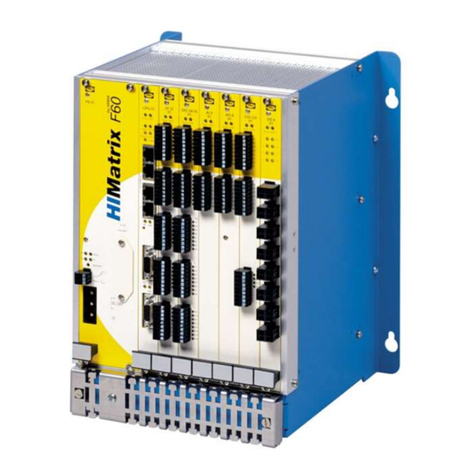
HIMA
HIMA HIMatrix F60 Installation and operation manual

HIMA
HIMA HIMax X-CI 24 51 User manual
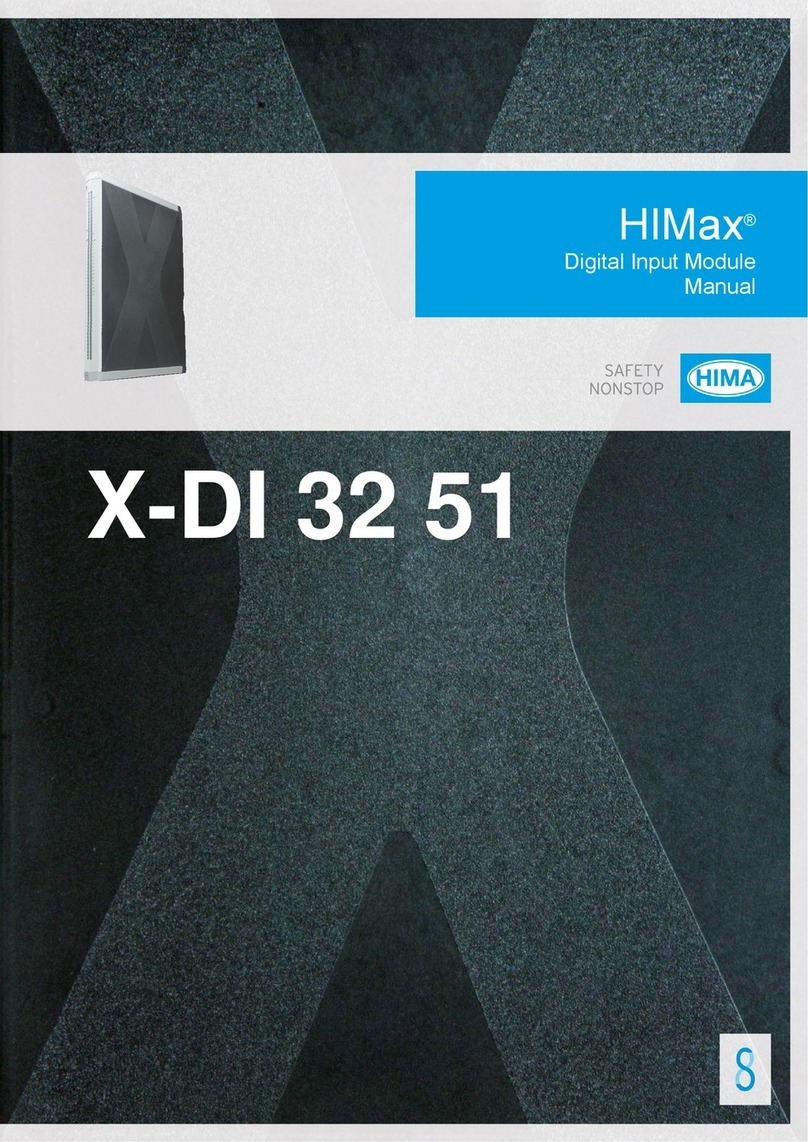
HIMA
HIMA HIMax X-DI 32 51 User manual

HIMA
HIMA HIMax X-DI 32 05 User manual

HIMA
HIMA HIMax X-DI 64 01 User manual
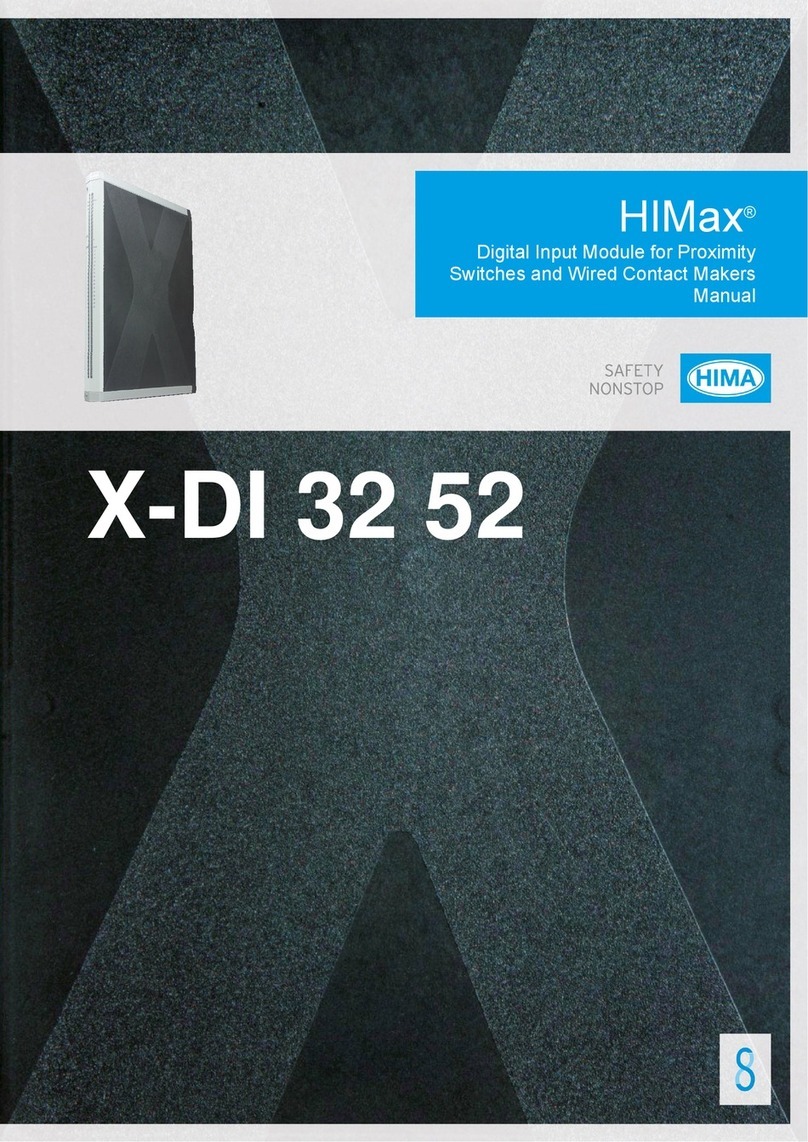
HIMA
HIMA HIMax X-DI 32 52 User manual
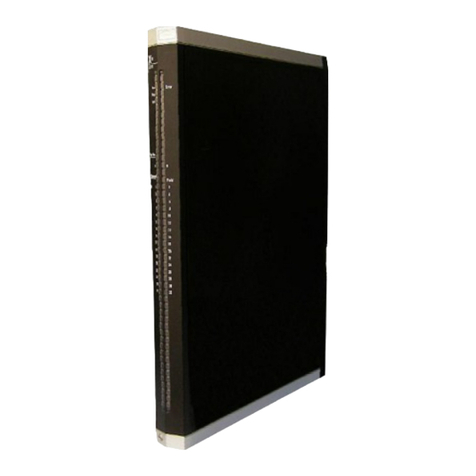
HIMA
HIMA HIMax X-DI 32 02 User manual
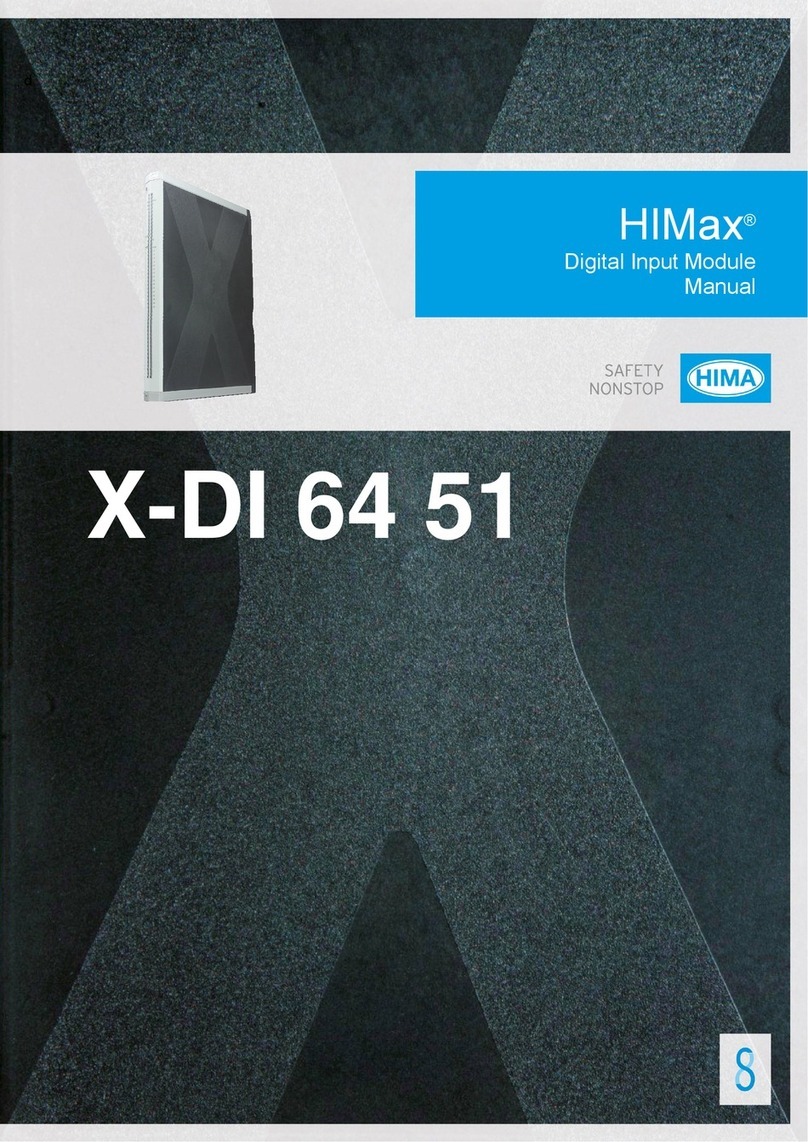
HIMA
HIMA HIMax X-DI 64 51 User manual
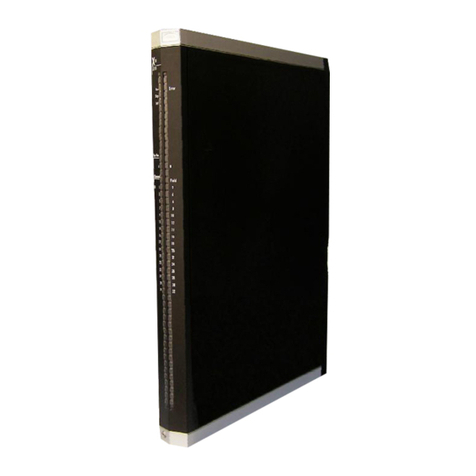
HIMA
HIMA HIMax X-HART 32 01 User manual

HIMA
HIMA HIMax X-DO 32 51 User manual
